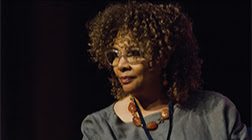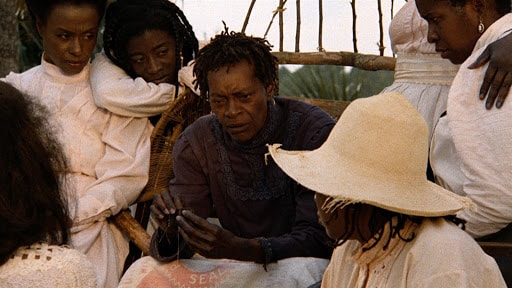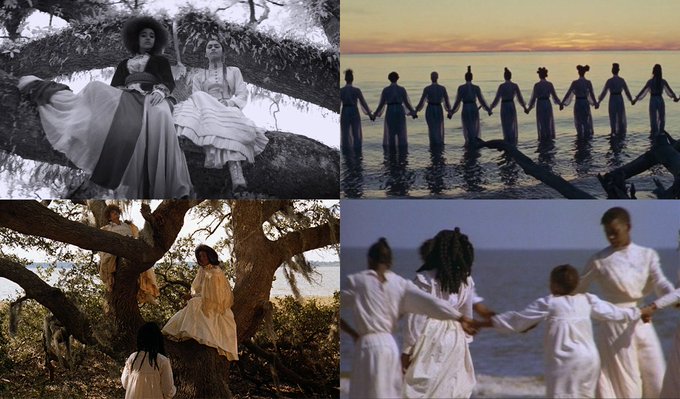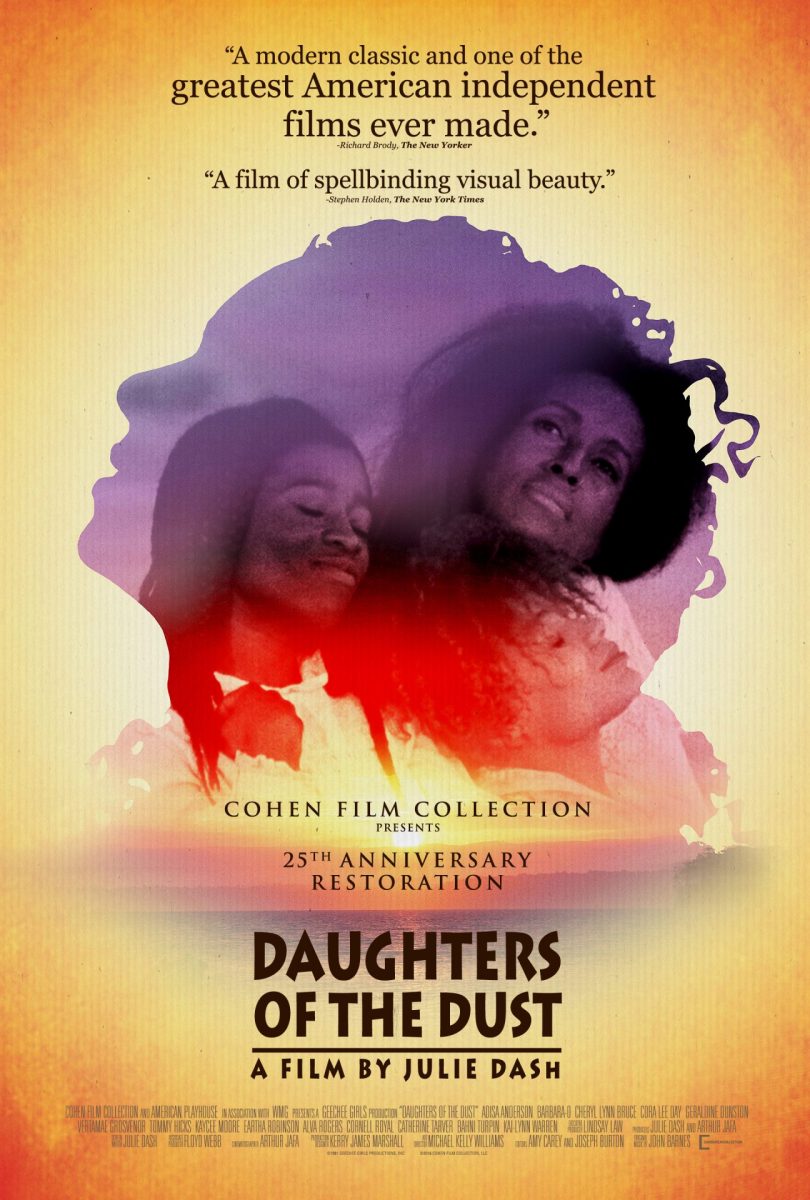(Julie) Dash … has also been insistent on telling the … story not as a conventional straightforward narrative but in the manner of an African storyteller, or, as she herself describes the technique, ‘the way an old relative would retell it, not linear but always coming back around.’”
~ Kenneth Turan, film critic
In 1991, Julie Dash made history when her groundbreaking film, Daughters of the Dust, became the first feature film directed by a Black woman to receive theatrical distribution in the United States.
Premiering at the Sundance Film Festival, where it won the award for “Excellence in Cinematography – Dramatic”, Dash also wrote and produced the movie. Daughters of the Dust centered upon themes of Pan-Africanism, Black womanhood, memory, equity and legacy impacting a familial clan of Gullah heritage and is set in the Sea Islands at the dawn of the 20th century.
Born to Rhudine Henderson and Charles Dash on October 20, 1952 in the Queens borough of New York City, Julie was reared in the Queensbridge Housing Project in Long Island City. As a young adult, she studied at the Studio Museum of Harlem and at the Leonard Davis Center for the Performing Arts at City Colleges of New York, from which she earned her Bachelor of Arts degree in Film Production in 1974. Upon her graduation from City Colleges, Dash moved to Los Angeles, California, where she earned a two-year fellowship in producing and writing at Center for Advanced Film Studies at the American Film Institute. At the Institute, she studied under various filmmakers such as William Friedkin, Slavko Vorkapich, and, notably, Jan Kadar.
During her internship, she produced Four Women, a film that was later awarded the gold medal for Women in Film at the 1978 Miami International Film Festival. The 1974 film short was an interpretive dance based upon the song, “Four Women”, sung by Nina Simone. The lyrics in the song are divided among four verses, i.e. “characters”: “Aunt Sarah”, a woman who was enslaved; “Saffronia”, a mulatto woman who is a product of a White man who raped her Black mother; “Sweet Thing”, a young prostitute; and “Peaches”, a revolutionary young Black woman, determined to overcome the odds in life. Starring Linda Martina Young, who danced each of the four parts, the short centers upon the historic and contemporary trials, including racism and genderism, Black women experience.
Julie Dash continued her education and began her graduate studies at the University of California at Los Angeles (UCLA). There, she became a member of the new generation of Black filmmakers known as the “L.A. Rebellion”. This cohort included Charles Burnette (To Sleep with Anger, Killer of Sheep) and Haile Gerima (Embers and Ashes , Sankofa). The members were African and African-American filmmakers who studied and worked in the Film School at UCLA during the late 1960s to the late 1980s to create quality Black cinematic productions.
Dash also experienced an epiphany at UCLA. When in film school, she was interested in documentaries but in her graduate school experiences, she became greatly inspired by novels authored by Black women writers, significantly those by Toni Morrison (Sula, The Bluest Eye, Song of Solomon) and Toni Cade Bambara (Gorilla, My Love, The Salt Eaters). Because there was a dearth of these type of dramatic films, Dash decided to create these narratives. In 1977, she directed an adaptation of “Diary of an African Nun”, a story short by Alice Walker (Meridian, The Color Purple). For her adaptation, Dash won the student award from the Directors Guild of America.
Her inspiration to present these narratives was surely motivated by her life experiences and by studying her own cultural heritage. In 1975, she had already begun to study the Gullah heritage of her father. In 1981, Julie Dash was awarded a grant from the Guggenheim Foundation to research Geechee and Gullah culture, found among the descendants of enslaved Africans in the Sea Island communities in South Carolina and Georgia. Dash was both culturally and personally invested in this research.
Also during this time, she wrote and directed the short film, Illusions, which was released in 1982. In the short, Dash explored the myriad forms of racial and sexual discrimination against Black women in Hollywood and society. Set in a fictional movie studio during World War II, it is a story of two Black women, Mignon Duprée, an executive who is “passing” for White, and Ester Jeeter, a singer who dubs the vocals for a White star of Hollywood musicals. The underlying themes of truth, cultural identity and career advancement are examined in this film. It is critical to analyze how these themes are constructed, couched and promoted in a real-life motion picture and media industry of Hollywood, created and contingent upon fantasy, alternate possibilities and even escapism. Illusions received critical acclaim and was given the Black American Cinema Society Award in 1985 and named as “The Best Film of the Decade” by the Black Filmmaker Foundation’s Jury Prize in 1989.
In 1985, Dash graduated from UCLA with her Master of Fine Arts degree in Film and Television. Still working on her research of the Geechee and Gullah culture, she developed a story that would become the screenplay to Daughters of the Dust. Production began in 1988 when she was awarded $800,000 in financing from the Public Broadcasting Service (PBS). The film was completed and entered select theatres in 1991.
(No copyright infringement intended).
Spanning a one-day period and set on Dawtah Island in 1902, Daughters of the Dust presents a narrative focused on three generations of Gullah women in the Peazant family. These women are Nana Peazant, the Afro-spiritual matriarch who wants her family to stay on the island to retain their ancestral ties and customs; granddaughter, Yellow Mary, a bohemian who lives on the mainland; granddaughter, Viola, a devout Christian who prepares to leave their island; and granddaughter, Haagar, who desperately wants to leave because of the advancements of “civilized” society of the mainland. There is also Iona, Haagar’s daughter, who is secretly in love with St. Julien Lastchild, and wants to stay on their island. Finally, there is granddaughter-in-law, Eula, who is married to Eli and expecting a child. However, they are unsure of the paternity because she was raped by a White man on the mainland.
The film is narrated by The Unborn Child, the future daughter of Eula. Her life, yet to physically begin in This Realm, is greatly influenced by her ancestors and African spiritualism. In a powerful scene, Nana Peazant speaks on the love and value of the Unborn Child, “We are two people in one body. The last of the old and the first of the new.” Supporting characters include Daddy Peazant, the patriarch; Eli, Eula’s husband and Nana’s grandson; Mr. Snead, a photographer from the mainland who takes portraits of the islanders before the final departure from the island; Trula, the lover of Yellow Mary; St. Julien Lastchild, an Indigenous American, who refuses to leave the island; and Bilal Muhammad, a Muslim who also lives on Dawtah Island.
The plot is told in a circular pattern to illustrate the significant phases of the Gullah culture: the Past, the Present and the Future. Dash references this type of storytelling akin to a “griot”, as a griot is a human repository of oral tradition. A griot can be a storyteller, historian, poet, singer or artist and is highly respected in their community for their wisdom. Spirituality and religions that Blacks have practiced are featured throughout the film and involve the African practices, ancestral prayers and Gullah language of Nana, the Christian teaching of Viola and the Islamic prayer of Bilal. Also, the essentiality of history and veneration of ancestral ties are constantly revisited throughout the film. This involves the account shared by Eli and Eula at the family meal of the uprising and mass suicide of enslaved Igbo at Igbo Landing in 1803. The film ends with each member of the Peazant family having to decide whether to remain on the island and preserve their way of life or leave for the mainland to begin a new one.
Daughters of the Dust garnered critical praise for its use of authentic Gullah patois without English subtitles; complex, nonlinear storytelling; lush music composed by John Barnes; and its gorgeous cinematography and visual imagery by Arthur Jafa, the former husband of Dash. Her creation of this film presented the reality of the unique Gullah community that was able to retain many of its Africanisms, despite the American system of slavery, and the imperative value of Black womanhood. In a 1992 interview with film scholar and filmmaker, Zeinabu Irene Davis, published in Black Film Review, Dash commented, “I wanted to do something on African retentions and survivals because the Sea Islands had remained culturally isolated and insulated from Western cultural experiences … [the people of the Sea Islands were able to] maintain and preserve a wealth of West African traditions, mores and religion. So, it was an area which was ripe for discovering. Usually, when we see films and television productions on early African-Americans, they deal with African-Americans living in Alabama and Mississippi.”
Despite the critical acclaim and awards given to Daughters of the Dust, Julie Dash wasn’t able to get the financing to release another feature film. She, instead, set her eyes to write, produce and direct in television. In this genre, Dash again won accolades for her work, including for the CBS television movie, The Rosa Parks Story. Starring award-winning actress, Angela Basset, the film received several awards, including the NAACP Image Award for “Best Television Movie” and “Outstanding Actress in a Television Movie, Mini-Series or Dramatic Special” and the Family Television Award. Bassett was nominated for her first Primetime Emmy Award for her portrayal of Parks and Dash was nominated for “Outstanding Directorial Achievement” in the 55th Annual Directors Guild Awards, becoming the first African-American woman nominated in the category of “Primetime Movies Made for Television”.
Additionally, Dash also directed music videos for artists auch as Keb ‘Mo and Sweet Honey in the Rock. Her direction on the video, “Give Me One Reason” by singer, Tracy Chapman, was nominated for MTV’s Best Female Vocalist in 1996. In 2004, she was commissioned by the National Underground Railroad Freedom Center in Cincinnati, Ohio, to create the film short, Brothers of the Borderland. Narrated by Oprah Winfrey, it features a composite character, Alice, an African-American woman, who is aided in her flight to freedom by another African-American, John Parker, who is a “conductor” on The Underground Railroad.
Julie Dash has consistently produced pioneering works that stimulate and motivate others, especially Black women, to create and break barriers. After the release of Daughters of the Dust, the book, Daughters of the Dust: The Making of an African American Woman’s Film, was published in 1992. It was co-authored by two pillars of Black women’s literature, Toni Cade Bambara and bell hooks. In 1999, Daughters of the Dust: A Novel, was published. It is a sequel set during the Harlem Renaissance in the 1920s about the protagonist, Amelia Varnes, the granddaughter of Haagar. A Harlemite who studies anthropology at Brooklyn College, she visits Igbo Landing of Dawtah Island to meet her mother’s relatives and learns about her ancestral culture, kin, folklore and her place and purpose in This Realm. The novel earned positive praise and was nominated for the NAACP Image Award for Fiction.
Daughters of the Dust continued to gain high accolades. In 2004, it was selected for preservation in the United States National Film Registry by the Library of Congress as being “culturally, historically, or aesthetically significant.” Its images would significantly influence the creation of Lemonade, the critically-acclaimed and multiple award-winning 2016 visual album of Beyoncé. A salute to Black woman-ity, it, too, features narratives told from different vantages, as represented by each segment. Lemonade discusses everything from Black motherhood, Sistahood, food, water, landscape and love. Two in particular are highly influenced by Daughters of the Dust, “Formation” and “Love Drought”. The former shows her and her dancers in formal dress inside a parlor reminiscent of the early 1900s. The latter features Beyoncé and her dancers, all dressed in white dresses, seeming to walk on water to return to their “home”, a la Igbo Landing rebellion, as discussed by Eula and Eli in the film.
(No copyright infringement intended).
In 2016, Yohana Desta interviewed Julie Dash for her article, “How Beyoncé’s Lemonade Helped Bring a Groundbreaking Film Back to Theaters”, published by Vanity Fair. When asked about her impression and feelings regarding the renewed interest in Daughters of the Dust, fueled by Lemonade, she responded, “I was very pleased. Lemonade is just – it breaks new ground. It’s a masterpiece.” Dash considers the epic video album, “… a tone poem, a visual tone poem with various stories going on – vignettes. It’s just all visual and it’s like yes … I just love what she and her sister [Solange] do, what they represent … they reimagine and redefine the Diaspora. And it’s just like, ugh – sumptuous. Just sumptuous. I loved it. Every bit of it.” Beyoncé’s husband and sister would also share in her love for Dash’s work, as they selected Jafa as director of photography for Jay-Z’s video, “4:44”, and Solange’s videos, “Don’t Touch My Hair” and “Cranes in the Sky”.
In celebration of its 25th anniversary, the Cohen Media Group restored and distributed Daughters of the Dust in 2016. Though it was already planned, the excitement created by Lemonade, according to Dash, sped up the release.
(No copyright infringement intended).
In 2017, Dash directed episodes of Queen Sugar, a show on Winfrey’s network, OWN. Queen Sugar is based upon the bestselling novel of the same name authored by Natalie Basile and chronicles the life of the Bordelon siblings of Louisiana. It is no surprise that Julie Dash would direct episodes for this series, as it has featured a female director for every episode of the series, which like Dash’s work, examines and discusses class, gender, parity and culture as influenced by race.
In January 2019, 28 years after the premiere of Daughters of the Dust at the Sundance Film Festival, Dash announced she is finally going to direct her second feature film, a biopic on Black Power activist and attorney, Angela Davis. Operating her own film company, Geechee Girls, in Atlanta, Georgia, it is immensely inspiring that Dash continues to follow her own advice. In an interview with Flavorwire, an online culture magazine, Julie Dash affirmed, “… I think having gone to film school, we are aware of historical situations … That’s why it’s important to do the film that you want to do – and then let people come to it. They may not get it now, but they will get it by and by … Some films are made because they need to be made. They’re works of passion.”
“I … wanted to do a film that was so deeply embedded in the culture, was so authentic to the culture that it felt like a foreign film.”
~ Julie Dash
For greater enlightenment...
-
Daughters of the Dust 2K Restoration (US Trailer

-
Julie Dash - On Daughters of the Dust 25th Anniversary Restoration

-
Gullah Traditions of the South Carolina Coast

-
PBS – Gullah Culture

-
A Vanishing History: Gullah Geechee Nation

-
NOURISH -Dr. Howard Conyers: Gullah Geechee Food Traditions

-
LEMONADE Trailer - HBO




